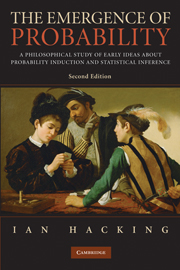 The Emergence of Probability
The Emergence of Probability Book contents
- Frontmatter
- Contents
- Introduction 2006
- 1 An absent family of ideas
- 2 Duality
- 3 Opinion
- 4 Evidence
- 5 Signs
- 6 The first calculations
- 7 The Roannez circle (1654)
- 8 The great decision (1658?)
- 9 The art of thinking (1662)
- 10 Probability and the law (1665)
- 11 Expectation (1657)
- 12 Political arithmetic (1662)
- 13 Annuities (1671)
- 14 Equipossibility (1678)
- 15 Inductive logic
- 16 The art of conjecturing (1692[?] published 1713)
- 17 The first limit theorem
- 18 Design
- 19 Induction (1737)
- Bibliography
- Index
14 - Equipossibility (1678)
Published online by Cambridge University Press: 05 April 2013
- Frontmatter
- Contents
- Introduction 2006
- 1 An absent family of ideas
- 2 Duality
- 3 Opinion
- 4 Evidence
- 5 Signs
- 6 The first calculations
- 7 The Roannez circle (1654)
- 8 The great decision (1658?)
- 9 The art of thinking (1662)
- 10 Probability and the law (1665)
- 11 Expectation (1657)
- 12 Political arithmetic (1662)
- 13 Annuities (1671)
- 14 Equipossibility (1678)
- 15 Inductive logic
- 16 The art of conjecturing (1692[?] published 1713)
- 17 The first limit theorem
- 18 Design
- 19 Induction (1737)
- Bibliography
- Index
Summary
In 1703 Leibniz told Bernoulli that Witt had computed annuities by the ‘usual method of equally possible cases’. Leibniz was wrong about de Witt, but his remark shows he was familiar with equipossibility. It is commonly supposed that this concept originated with Laplace around the end of the eighteenth century, but in fact it was commonplace at the beginning. Laplace did define probability as the ratio of favourable cases to the total number of equally possible cases, but so did Leibniz in 1678. The definition was in full vigour a century after Laplace and is still not dead. Here is an historical problem. How could so monstrous a definition have been so viable? Its inadequacy seems evident to us. I could quote any of a score of eminent critics. Here, for example, is Hans Reichenbach discussing a ‘principle of indifference’ in the foundation of probability:
Some authors present the argument in a disguise provided by the concept of equipossibility: cases that satisfy the principle of ‘no reason to the contrary’ are said to be equipossible and therefore equiprobable. This addition certainly does not improve the argument, even if it originates with a mathematician as eminent as Laplace, since it obviously represents a vicious circle. Equipossible is equivalent to equiprobable [1949, p. 353].
Even workers who in our century have defended equipossibility have done so because they have philosophical views about the impossibility of producing non-circular definitions. Thus Émile Borel, to whom all probabilists owe so much, maintained that such circles were not vicious. It is an error of logicians, he thought, to try to produce a non-circular definition of probability [1909, p. 16].
- Type
- Chapter
- Information
- The Emergence of ProbabilityA Philosophical Study of Early Ideas about Probability, Induction and Statistical Inference, pp. 122 - 133Publisher: Cambridge University PressPrint publication year: 2006
